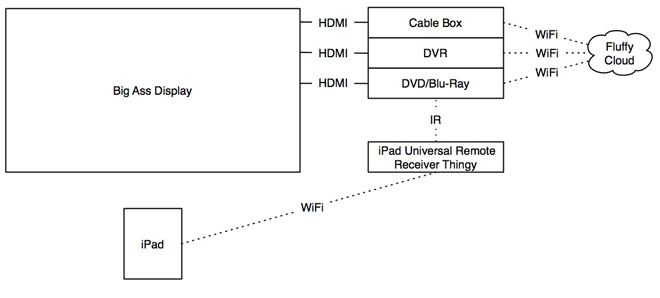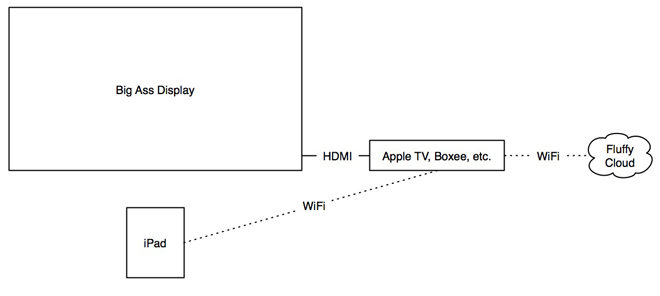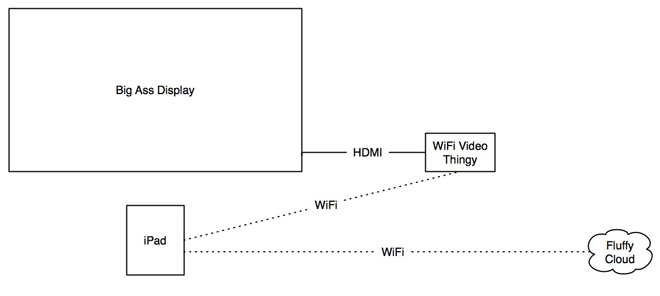One of the iPad apps that most people think is inevitable is some kind of remote control for home entertainment systems, but I think the conventional wisdom on this isn’t thinking big enough because we just can’t shake the idea of a “remote controller”.
The basic idea is that you’d throw away all your remote controls and have the most fabulous remote control of all time, with the ability to manipulate multiple hardware devices and systems, of all kinds and from different manufacturers, even some devices that enable viewing internet videos such as from YouTube or Netflix, all using a single awesome iPad graphical UI. You could preview what’s on other channels while watching a show on the big screen, scroll through TV schedules on the little screen without changing what’s on the big one, finger-tap on show titles to add them to your DVR queue, etc.
To do all this, there would need to be some additional device to translate the iPad’s output — which is basically WiFi — to what most set-top devices need for input — infrared light (IR). This “Universal Remote” iPad app would also need to be programmed to know the IR codes for most set-top devices, just like thousands of other so-called “universal remotes” do.
Here’s what this system might look like:

Of course, some more visionary people predict the death of these multiple devices and envision them all being replaced with a single multi-purpose device for streaming video from the internet, recording cable programming, playing discs, browsing a personal media collection, and more. Devices like Apple TV and Boxee. In fact, many Apple observers already suspect that the iPad will become the killer remote control for the next version of Apple TV.
This is obviously a much simpler configuration, and looks something like this:

But what if we take this just one step further, and take the expensive devices out of the loop completely? Imagine a system like this:

The iPad uses WiFi to pull content off the Internet (or from its own library), and then uses WiFi to push video to the big ass display, possibly with the help of a cheap WiFi video “receiver” unit (which, come to think of it would be trivial to build directly into monitors).
In this model, the iPad itself replaces all of the set-top devices. While the iPad cannot play Blu-ray disks, it can certainly do everything else in this list. Why should Apple bother making another version of Apple TV when they could build all of the functionality of Apple TV into the iPad itself? All the storage, all the video, audio, and picture playback, all the online video browsing, all of it built into the iPad.
All the games, too. So long Xbox, Playstation, and Wii.
In this model, your “home entertainment center” is all contained in software. The only hardware you need is that big screen. Or select from multiple screens around the house, using only software to determine which screen you want to “project” on to.
Obviously there are technology constraints here, but they are all the usual constraints that inevitably fall aside faster than we generally imagine: network speed, processing power, and memory. HD digital video is a lot of bits to go over a wireless connection. But if you imagine all of these technologies being even only a little better than they are now, we’re basically there.